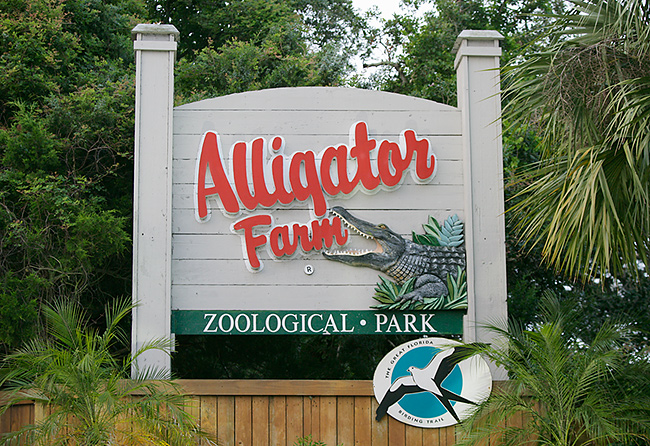
BIRDS AS ART BULLETIN #232
MAY 23, 2007
Visit: www.birdsasart.com
ST. AUGUSTINE ALLIGATOR FARM IPT REPORT
ROBERT O’TOOLE’S APATATS -1 NOW SHIPPING
FLEDGED BABY (BLUE-FACED) SPOONBILLS OUT OF THE NESTS WITH JAMES SHADLE
MICROFIBER CLOTHS & GIOTTOS ROCKET BLOWERS NOW AVAILABLE (FOR SENSOR CLEANING IN CONJUNCTION WITH THE LENS PEN)
COMMENTS FROM A FRIEND/WHAT MAKES A GOOD PHOTOGRAPH?
A CHEATER WITHOUT INTEGRITY; IS IT TRUE?
BAA/GUSTAPHOTO AFRICAN SAFARI UPDATES
CANON GEAR FOR SALE
SELECTED IPT UPDATES

Contact us by phone at 863-692-0906 (Eastern Time Zone) or by e-mail at birdsasart@att.net or birdsasart@verizon.net. The att e-mail address is best from overseas.
We gladly accept credit card orders by phone 8am till 9pm Eastern Time (8 am till 3pm Fridays).
You can use the Paypal links on the web site to order anything. Just type in the item(s) and the amount. If using your own Paypal account, please send to either of the e-mail addresses above.
Photographic theme: some of my favorite images from the St. Augustine Alligator Farm IPT.
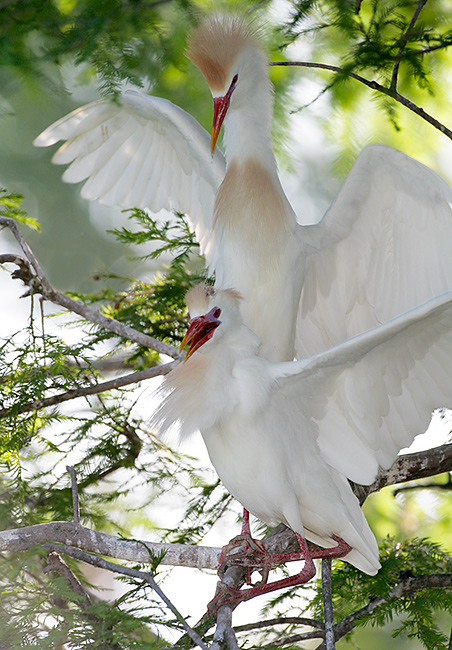
Cattle Egrets copulating, St. Augustine Alligator Farm, St. Augustine, FL
Image Copyright 2007: Arthur Morris/BIRDS AS ART
Canon 500mm f/4L IS lens with the EOS-1Ds Mark II. ISO 400. Evaluative metering +1/3 stop: 1/250 sec. at f/7.1. Fill flash at +1 stop.
I did not use the Better Beamer here as I was working backlit subjects on a clear sunny day. If you accidentally point your lens at the sun the fresnel screen from the beamer will likely burn a hole in the front of your expensive flash…
ST. AUGUSTINE ALLIGATOR FARM IPT REPORT
When I arrived at the St. Augustine Alligator Farm last Wednesday afternoon to scout for the IPT, it seemed that the photographic opportunities were not as good as they had been in previous years. Two years ago the rookery underwent a re-vegetation project; many exotic plants were removed and many new native shrubs and small trees were planted. And those new plantings are flourishing. Wood Stork numbers are down drastically and many Wood Stork nests failed (most likely because of lack of food). In most years there are several easy-to-photograph Great Egret nests with young below eye level; this year there were none.
As it turned out, I was dead wrong. The rookery continues to be an amazing place to photograph birds; we had dozens and dozens of amazingly wonderful photographic situations. On Thursday afternoon I was joined by eleven photographers, each eager to learn. There was nobody from Florida, two “local” folks from Georgia (Ty Ivey and IPT veteran Joe Barranco), one from NY, (Christine Fisher, an excellent photographer with less than two years of experience—ain’t digital amazing?), Tom Ambrose from Vancouver, WA, a father and son team (Vernon and Mike Baker from AZ and PA respectively), multiple IPT veteran, good friend, and excellent photographer Jack Panzeca (TX), IPT veteran Mike Goldhammer from San Diego, and three other newcomers: Mike Cornwell (VA), Danny Lloyd (NC), and Mike Poe (TN). I owe Mike a big time thanks… I bumped my 500 against the boardwalk railing and the hood (about $700) fell into the dark water. A gator took a chomp at it as it sank. One of the keepers tried unsuccessfully to retrieve it that afternoon. Late in the day I asked a (tiny) young lady keeper to bring us a net. I stuck it in the water and wham! A huge gator grabbed the net and almost pulled me into the water. I tried a few more times and the gators swarmed around biting at the net, attracted by the movement. I gave up. Someone else made a half-hearted try, and then Mike Poe took over. I watched him for a few minutes and then gave up. Ten minutes later he came walking down the boardwalk, net in hand and a big smile on his face. Thank you Mr. Poe! (We had four Mikes on the trip.)
I think that this group learned more than any other IPT group ever. On many tours, I feel lonely. Folks rarely ask me questions. They rarely follow me around. During each IPT’s introductory slide program, I always mention that the best place to be is right next to me, and that the only way to go home unhappy is to fail to ask questions. Well this group believed me and really out-did itself. We had four great in-classroom sessions; I rent the education center at the Farm for our lessons. When I asked if anyone wanted to take a walk around the zoo portion of the Farm one day when the light got harsh, seven or eight of the group joined me. When some spoonbills landed in the big perch tree they were directly backlit; when folks started for the tree, I called out, “Waddya doing? What about sun angle???” Five or six folks joined me as we took a walk through the Gomek memorial and found a few spots right on sun angle with clear views of the perched spoonbills. After a few minutes, I headed back to the boardwalk and rounded up the rest of the boys and girls with big lenses.
We had great weather: 1 ½ days of mostly cloudy, and 2 days of sun. (I love the clouds way better.) And it was pleasantly cool throughout (save for the first afternoon). We had great food, most of it at the Gypsy Cab Company right down the street. The staff at the Alligator Farm was helpful and pleasant. And nobody in the group even came close to being banned for life <smile>. All of the regular teaching posse members made the trip: Robert and Robert and Alfred and Fabs. And my main man Jim Litzenberg took a busman’s holiday and joined us. Everyone got along great and a good time was had by all. Especially me.
One last item: after my two hour Digital Workflow/Photoshop program on Sunday afternoon Robert O’Toole did a short APTATS program; everyone was amazed and I am pretty sure that pretty much each and every person purchased the APTATS CD. (See below for details.)

Snowy Egret in spectacular breeding plumage, St. Augustine Alligator Farm, St. Augustine, FL
Image Copyright 2007: Arthur Morris/BIRDS AS ART
Canon 70-200mm f/4L IS lens (handheld at 230mm) with 1.4X II TC and the EOS-1Ds Mark II. ISO 200. Evaluative metering at zero: 1/800 sec. at f/5.6. Fill flash at -2 stop.
This spectacular bird showed up on our last afternoon and spent two hours displaying almost within arm’s length; what a way to finish! I verified the correct exposure by checking the histogram. Subject in shade, background in sun is one of my favorite situations.
ROBERT O’TOOLE’S APATATS -1 NOW SHIPPING
We began shipping Robert O’Toole’s Advanced Photoshop Tips and Techniques Simplified-1 (APTATS-1) PDF (available only on CD) last week.
Robert’s Quick Mask techniques will let you work faster and more efficiently. If you regularly use either the Clone tool or the Patch tool, learning to use Quick Masks instead will totally change the way you do things and approach difficult problems. The five topics covered clearly and concisely in APTATS-1 are:
1: Quick Mask Object Removal
2: Eye realignment and Repair
3: Restoring Highlight Detail
4: Clipped Feather Tip Repair
5: Clipped Wing Repair (with Exposure Adjustment)
With a bit of practice, using the techniques will become second nature. Once you learn the basics of using Quick Masks, you will find yourself using them for many tasks that are not specifically covered in the PDF.
You can order your APTATS-1 PDF (on CD only today for $20 plus $3 shipping and handling ($23 total) in the US. Florida residents need to add 7% sales tax: $21.40 plus the $3 shipping and handling ($23.40 total). To Canada the cost is $20 plus $6 shipping ($26 total). For overseas customers the cost will be $20 plus $8 shipping and handling ($28 total). APTATS-1 is being shipped in its final form; it will not be updated. (We regret that recent US Postal Service increases have forced us to raise the price for shipping CDs from $2 to $3.)
As is usual Paypal is quite convenient. Be sure to include your ship-to address. You can call us at 863-692-0906 with credit card in hand, or send a check for the correct amount made out to “Arthur Morris” to us as follows: Arthur Morris/BIRDS AS ART, PO Box 7245, 4041 Granada Drive, Indian Lake Estates, FL 33855.
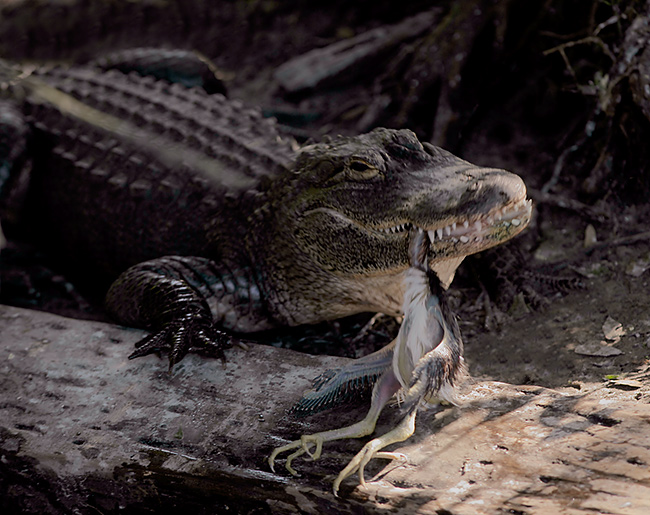
American Alligator (captive) eating Tricolored Heron chick, St. Augustine Alligator Farm, St. Augustine, FL
Image Copyright 2007: Arthur Morris/BIRDS AS ART
Canon 300mm f/4L IS lens handheld with the EOS-1Ds Mark II. ISO 400. Evaluative metering -1 stop: 1/200 sec. at f4.
Tough the gator was in the dark, the board was in bright sun. I underexposed by one stop to try to save the highlights (on the sunlit board), but they were still over-exposed a bit. I used a combination of techniques to even out the exposure and reduce the great contrast.
FLEDGED BABY (BLUE-FACED) SPOONBILLS OUT OF THE NESTS WITH JAMES SHADLE
James Shadle has advised me that many baby Roseate Spoonbills have fledged on the Tampa Bay rookery islands. For the next three to four weeks there will be amazing opportunities (weekdays only) to photograph these fledged youngsters at close range (oh, those ultramarine lores!) and begging for food from their parents. Just fledged spoonbills are an almost pure white with amazingly sky blue facial skin and lores. To explore the possibility of making a boat trip with Jim try him on his cell at 813-363-2854 (do leave a message if he does not pick up) or send an e-mail to James@wildflorida.net.
The weather forecast (sunny with northeast winds) for tomorrow morning (Thursday, May 24, 2007) is perfect. I will be leaving Indian Lake Estates at 4:45am, abandoning both the complete home re-modeling project that I have undertaken and the tons of work that I have to do to photograph the baby spoonbills… If you would like to join us on the morning of Thursday, May, 24th (while learning from two great instructors for the price of one), call me at the office today at 863-692-0906. James’ standard rates will apply.
If not, do consider a trip with Jim between now and mid-June. (There are still lots of adult spoonbills in breeding plumage around, and just-fledged White and Glossy Ibises should be out of their nests any day now.
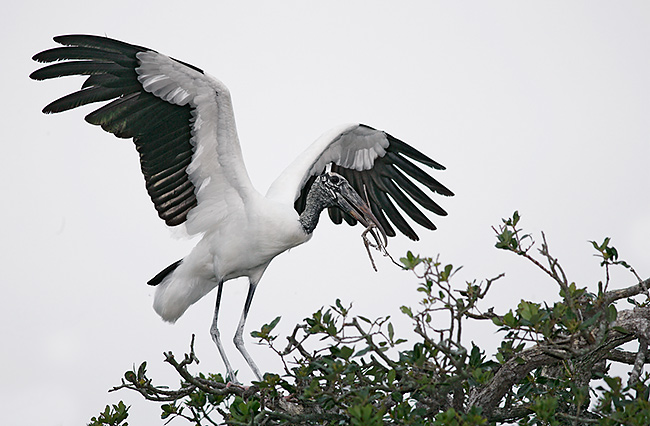
Wood Stork with nesting material, St. Augustine Alligator Farm, St. Augustine, FL
Image Copyright 2007: Arthur Morris/BIRDS AS ART
Canon 400mm f/4L IS lens (handheld) with the EOS-1Ds Mark II. ISO 500. Evaluative metering +1 2/3 stops: 1/1000 sec. at f/5.6. Fill flash at zero with the Better Beamer.
I was lucky to have the right lens in my hand at the right time... Late on a cloudy, white-sky day, the camera’s meter is dumb when it sees white. It is programmed to make white grey in these conditions, so I added lots of light to keep he overall light scene light. To learn about “Exposure Simplified”, order your copy of my great new CD book ABP II now: http://www.birdsasart.com/ABPII.htm
MICROFIBER CLOTHS & GIOTTOS ROCKET BLOWERS NOW AVAILABLE (FOR SENSOR CLEANING IN CONJUNCTION WITH THE LENS PEN)
As per our detailed e-mail instructions, when you first use a Lens Pen for sensor cleaning you need to tap the tip of the Lens Pen on a micro-fiber cloth to remove the dry lubricant. In addition, you need a good blower bulb to clean the chamber and to blow away the loosened sensor dust.
For the convenience of our many customers, we have added the Tetenal Microfiber lens cleaning cloth and the Giottos Rocket Blower to our mail order line-up. The Tetenal Microfiber cloth is white, 8X10 inches, does not have any metal clips or fasteners on it, and is washable. After using your microfiber cloth to remove the lubricant on the tip of the smaller Lens Pen you can use the cloth to clean the front elements of your lenses safely without having to wash it.
I have been using the Giottos Rocket Blower for years; it is the best available. (Do not be tempted to order the more expensive model with the angled nozzle; there are reports of the tip coming loose when folks were blowing the dust off of the sensor…)
We advise that folks purchase both of these accessories when purchasing a Lens Pen combo kit.
Tetenal Microfiber 8X10” Lens Cleaning Cloth: $8.99 + $2.01 shipping and handling = $11.00 total. Florida residents need to add $.63 sales tax bringing the total with shipping to $11.63.
Giottos Rocket Blower (7.5" tall, 2.25" nozzle, 2.4" diameter): $10.94 plus $3.06 shipping and handling = $14.00. Florida residents need to add $.77 sales tax bringing the total with shipping to $14.77.
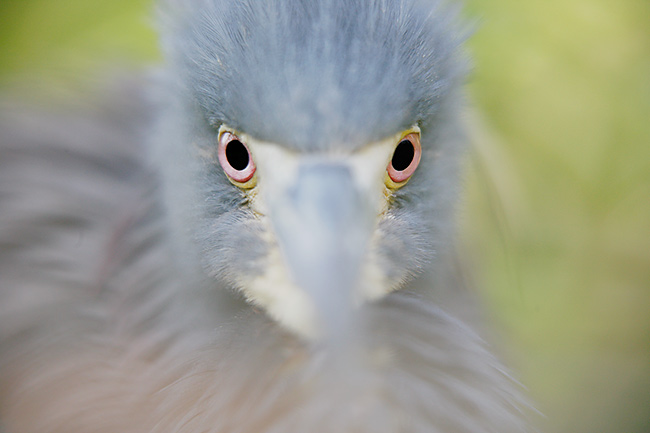
Tricolored Heron, St. Augustine Alligator Farm, St. Augustine, FL
Image Copyright 2007: Arthur Morris/BIRDS AS ART
Canon 70-200mm f/4L IS lens (handheld at 200mm) with 75mm of extension and the EOS-1Ds Mark II. ISO 400. Evaluative metering at zero: 1/400 sec. at f/2.8.
This bird was sitting placidly on its nest right next to the boardwalk. I needed the three tubes (two 25s and a 12) so that I could focus well inside my lenses minimum focusing distance. I chose the f/2.8 aperture to accentuate only the eyes.
COMMENTS FROM A FRIEND/WHAT MAKES A GOOD PHOTOGRAPH?
A while back, I contributed a short essay to a Houghton Mifflin book project, “Good Birders Don’t Wear White.” It is a good read for, you guessed it, birders, but there are several photography-related essays including mine, and one written by a long time friend, Richard Crossley. Richard is one of the world’s premier birders with almost unparalleled identifications skills. When Elaine was still alive, we often kept our motor home in Richard and Deb’s driveway, ran a long cord through there window, and plugged into a socket in their living room.
Richard, along with Kevin Karlson and Michael O’Brien, is one of three authors of the fairly new (and excellent) book, “The Shorebird Guide” (also a Houghton Mifflin book).
Richard kindly allowed me to reprint his essay from “Good Birders Don’t Wear White” here. My comments will follow. Passages of particular relevance to me are italicized.
I am often asked ‘what are you’ – photographer or birder? Considering that for years I have told people that it is impossible to be both, I am now in a pickle. I started birding aged 10, by the time I was 14 it was starting to take over my life, by 19 it WAS my life, and at 21 I had put myself in numerous situations where it could have taken my life. I dragged my wife across the Atlantic Ocean so I could live with the birds – in Cape May, NJ. So I am a birder!
Although I have played with photography for 20 years, it wasn’t until the early days of ‘The Shorebird Guide’ that my life would take another obsessive turn. When told it was impossible to get the images (the fancy way of saying photographs) that we needed for the book by respected professional bird photographers, there could be only one response - prove them wrong. So the first lesson is,” don’t always believe the experts because they are wrong far more often than you may think”. But when I think of the many family dinners I missed just to get a flight photo of one bird, an American Woodcock, perhaps I was wrong.
Now, 4 years on, I go nowhere without a camera. I hate to say this but I occasionally get way into the field before realizing I forgot my binoculars. I suppose if I can’t be both a photographer and a birder, that makes me a bird photographer with a bit of inside scoop on birds. And yes, they are tricky little so and sos. They move fast, are nearly always not as close as we want them to be. So if you do what bird photographers are supposed to do, i.e. put a big camera lens with lots of cords, flashes and other rigmarole on a big tripod and walk up close to birds while they smile at you, well, good luck.
To a bird, we look huge, probably something like an elephant would look to us. So thinking that birds can’t see us, bright clothes or not, hiding behind trees with big tripods.... what must they think! In my foreign travels I tended to skedaddle very quickly when an elephant came towards me. Anything that was moving very slowly got a second look and with time a comfort level builds up. Birds are scared by the same actions as we are and they react just as we would to an elephant. Change is the biggest factor. If a group of people are stood quietly but suddenly someone makes a quick movement or speaks loudly, the sudden change is a great bet for the birds to fly away. Even clicking your camera as you are getting closer to a bird is a great idea so the bird is familiar with the sound. Constant loud noise is often not a problem if there are no sudden changes in the volume.
Back to the elephant. If it were on its knees or lying down would it be less threatening? Absolutely. The closer objects are the bigger they look. Okay, so you know what is coming next. That’s right, down you get. Crawling is the way to go if you are in the right environment, that is, on the beach or on short grass. But what about all my gear? Dump it!
Now I am getting into really sticky ground with a lot of photographers. But let’s have a look at that. Tripod – what do you need it for? Rest your lens on the ground, hand or on your binoculars, depending on what angle you need. It is amazing how many natural tripods such as trees and fences there really are. Personally, I prefer to be without a tripod as they limit movement and make it very difficult to shoot moving birds. If I intend to be relatively stationary then I will use one. If you are able to hand hold your lens you can cover much larger areas in search of your prey. Then, when you see your target, you can take shots immediately. It is also easier to get closer to the subject because of the reasons already mentioned. Yes, there is a downside, particularly being able to shoot at very slow shutter speeds. Thus being able to shoot at high ‘f’ stops to get the depth of field and the scenic backgrounds I love. If you shoot ‘wide open’ (low ‘f’ stops) taking sharp photos should be no problem, particularly with an image stabilized lens and digital cameras that shoot good images at high ISOs.
As for the other equipment such as flashes, are they vital? In poor light they make the image more visually appealing. However, they are not an accurate portrayal of the image as we see it. For someone who has spent many years studying the minutiae of bird identification and the effect light has, the use of flash is particularly distracting. I was also influenced by a two year stint in Japan, where bird photography had much more emphasis on natural light and images told the story about the bird and where it lives. Here in the US the image of choice seems to be a close up with sharp feather detail (probably with a bit of fill flash) with a nice uni-colored background – an image we essentially never see in reality through binoculars or with the naked eye. But it sells! It is not my cup of tea. So, you see I am a little biased when I say ‘life goes on without a flash’. In any case, for those who are a whiz in Photoshop, you can pretty much do whatever you like and fix it later.
So what is a good image? My Dad, an impressionistic artist in the Van Gogh mold, describes art as “a pleasing arrangement of color and shapes”. When I think about it, this is how I see birds. I see shape and movement both in black and white and color in the beautiful places that they live. I do not see them in incredible detail, close-up with a uni-colored backdrop – do you? As to the answer to the question “What is a good image?” That’s easy, one that looks good to you and damn the experts!
When I first read Richard’s essay, I was pleased to note that he had—without mentioning my name once—insulted me and my style of bird photography throughout. (It is always more flattering to at least be noticed than to be ignored.) I intended to write him a short note of thanks, but was too busy. Two weeks ago, he called, so I got the chance to thank him. Let’s side-track to “The Shorebird Guide” for a moment. It is a great book for those interested in the fine points of shorebird identification. (By shorebirds, birders are referring to the avocets, stilts, oystercatchers, plovers, and sandpipers, not to birds of the shore like gulls and herons. Don’t get me wrong, there are zillions of birders out there. I used to be one myself.)
The Shorebird Guide is a wondrous book, especially for someone like me who is a shorebird nut. (If you are not a shorebird nut but would like to learn the basics of aging and identification of North American shorebirds, I can strongly recommend my “Shorebirds; Beautiful Beachcombers” (http://www.birdsasart.com/books.html#SHOREBIRDS). Above, Richard wrote, “When told it was impossible to get the images (the fancy way of saying photographs) that we needed for the book by respected professional bird photographers, there could be only one response - prove them wrong.” Richard was looking for images featuring small flocks of roosting shorebirds that included several species for side-by-side i.d. comparisons, and in addition, was looking for similar images with the birds in flight. I had assumed that he wanted good or excellent photographs, that he wanted all of the birds sharp and in focus, that he was looking for photos that were pleasingly composed, and that the birds in the flight images featured pleasing wing positions. As it turned out, I was wrong. He was just looking for images that would fit with the concept of the book: identifying shorebirds by their sizes and shapes. When we spoke, I told him that I felt that many of the images that were perfect for his book were simply not good photographs. He begged to differ stating that if he liked the images and other folks did also that the images were both good photographs and art… Lastly he wished to include images of shorebirds in their natural habitats. There, he succeeded to some degree but many of those images were simply not good photographs. I continued by saying that in my book, bad photographs should not and could not be considered art no matter how many folks like them. He countered by saying that lots of folks loved the images in the book. I said, yes, they liked the images because of their value to the book. If they thought that they were good photographs, then they needed to be educated <smile>. Or, as I have said many times (and gotten in trouble for saying it), there is no accounting for taste.
I must re-iterate: “The Shorebird Guide” is a fabulous book for shorebird addicts. If you are one, you need to get a copy ASAP. I keep my copy on the tub next to the throne for easy access. And, there are some great images in the book: Alan Murphy’s Wilson’s Plover at a nest with eggs (49 top), Kevin Karlson’s breeding adult Sanderling (143 top) and his classic displaying Buff-Breasted Sandpiper (192 top), the juvie Stilt Sandpiper (185 bottom), the juvenile Red-necked Stint (283 bottom left), and the fresh juvenal plumaged Sharp-tailed Sandpiper (294 bottom). And there are many others that I missed including several by K.K. Hui and Mike Danzenbaker. From and artistic standpoint, however, the bad news is that the vast majority of the hundreds of images used effectively in the book are not good photographs, and therefore, not—in my book—art.
Richard is a very good bird photographer. For years he used “only” my beloved toy lens, the Canon 400mm f/5.6 L lens but has since graduated to big glass himself (though you would never know it from reading his article) <smile> Yes, you can make some good images with that lens, and yes, getting low or better yet, right down on the ground can help you to get closer to the birds, but Richard’s suggestions that folks should not use their tripods and throw away most of their gear are absurd. Though I make lots of wonderful images with the shorter focal length lenses, big glass with either the 1.4 or 2X TCs are my bread and butter, and if I am not crawling around in the mud with them they are always used on a tripod.
As for Richard’s railing against the “uni-colored (even-toned) backgrounds pretty much define my style, I could care less that folks do not see the birds looking like that. My style has worked well for me and with many folks emulating my style, I am flattered. In our phone conversation Richard stated that the popularity of this style was mostly my fault. I responded by stating that I always encourage folks to experiment with various styles and pick that one that they like best. I can teach them to create images with backgrounds of pure color, and do so often, but I never force my style on anyone. Richard’s statement that “… for those who are a whiz in Photoshop, you can pretty much do whatever you like and fix it later” promotes a common myth. JIJO. Junk in equals junk out.
Lastly, Richard concluded his essay by writing: As to the answer to the question “What is a good image?” That’s easy, one that looks good to you and damn the experts! If an image looks good to you but is unsharp, contains distracting elements, poor wing positions, poor head- and light-angles, clipped toes or feet, birds cut off by the frame edges, etc., etc., etc., then they are not good photographs and they are certainly not art.
I will publish Richard’s (expected) response in a future Bulletin. I thank him for letting me reproduce his essay here. Not to worry, we shall remain great friends to the end.
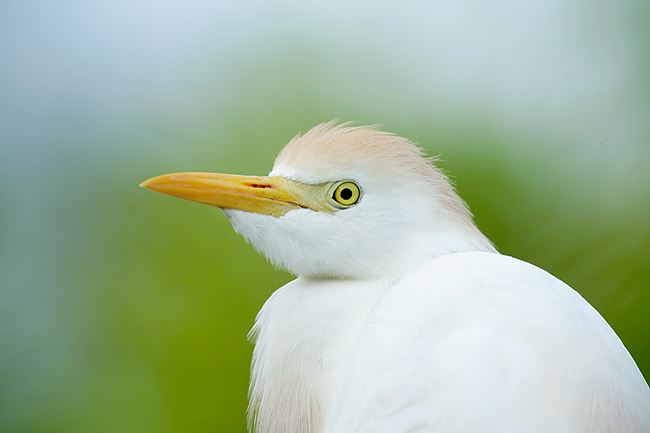
Cattle Egret, post-breeding plumage, St. Augustine Alligator Farm, St. Augustine, FL
Image Copyright 2007: Arthur Morris/BIRDS AS ART
Canon 500mm f/4L IS lens with the 2X II TC and the EOS-1Ds Mark II. ISO 400. Evaluative metering +1 stop: 1/200 sec. at f/8.
Sometimes simple can be elegant. I guess that Richard Crossley would not like this image as I used a long lens and a tripod and the image features a clean, out-of-focus background… <smile>
A CHEATER WITHOUT INTEGRITY; IS IT TRUE?
Below is my response to a photographer from South Africa whom shall remain un-named. Though he did sign his name to the e-mail, we shall designate him as AS (anonymous subscriber).
Dear AS,
re:
AS: Thanks for the great newsletters and info. I always enjoy them and the tips you offer.
AM: I am glad for that. Thank you.
AS: I thought I would make a gentle protest at the example you gave in the Bulletin 231 showing the Quick Mask Object Removal technique that you used to remove the two distracting birds in the foreground. You know, we (all photographers, that love making great wildlife pictures) would like to have every picture clean, crisp, composed and perfect, but the most incredible satisfying reward is when we are better positioned, with the light right, the preparation timing kicks in, equipment is primed and ready to shoot and BEEP, CLUNK, or CLICK, on review, there out of 20 shots, there it is. The perfect shot. The one off! The thrill, accomplishment, satisfaction and personal reward is worth more than anything else. Yet within a couple of minutes in Photoshop one can take a lousy snap and make it look good?
(Note from AM: I have chosen not to correct AS’s numerous grammatical errors.)
AM: That is a statement not a question. I disagree strongly. Junk in equals junk out. You cannot make a bad picture into a good picture in Photoshop. You can improve the artistic quality of a good image. If you wish to call the result a photo illustration, I am fine with that.
AS: Sure, the bird landing is nice, but what about getting the real shot, belly down, at eye level, and hey, I learn from you! Come on; keep the passion burning for the right reasons and the love of making a great image with the camera, at the time.
AM: Ah, so you are God. You know the right reasons for the passion to burn. I can, however, assure you that Photoshop or not, my passion for birds and photography burns brightly.
AS: Photoshop can be wonderful and has become an expensive necessity…
AM: Again, that is your opinion.
AS (continuing from above) … in ones digital workflow, but good shots don’t need that much work.
AM: I agree.
AS: The work is done in getting to the right place, right time, and right camera equipment, being prepared for the right moment, having the right knowledge and clicking at the right time, and then there’s the right luck, the fancy, techniques, as above, are for the commercial guys, for fashion and fine arts, sciences and the like.
AM: Ah, there is God at work again; he knows what is best for whom… I see myself as using modern tools to make good photographs better. I attempt to make images that please me and excite lots of folks. And how can I be a cheater if I tell folks exactly what I do?
AS: And we all know those fashion model images are cheats with a lot of work done in Photoshop.
AM: I am thrilled that you are classing me as a cheater in your gentle protest.
AS: I strongly believe that all wildlife moments reach us on a different emotional level and should not be faked.
AM: As I have written, when I optimize an image in Photoshop to improve it artistically the resulting image is always true to the natural history of the moment. By true to the natural history of the moment I mean that the bird is doing in the image what it was doing when I made the image and that nothing has been added that was not there at the moment of exposure. That is my personal ethic and if yours is different I am fine with that. Wishing me to live by your personal ethic gets us back to the God thing again. To quote Byron Katie (www.thework.org), there are three kinds of business: my business, your business, and God's business. My photographic ethics are my business not yours.
AS: Rather proudly present a spectacular image AS IS, an unadulterated capture of that moment where the integrity of image is pure.
AM: Like Ansel Adams did, right?
AS: Who could be proud of a shot like the above and show friends, peers and the like?
Everyone, I would assume.
AS: Think back to the various prestigious wildlife photographic competitions…
AM: When I enter a contest I follow the rules carefully; if a contest limits Photoshop work to adjusting color and contrast and removing dust spots, I submit only images that meet those criteria.
AS: … the National Geographic and what fascinates, stimulates and challenges people with cameras to want to produce like great images and memories.
AM: There you go playing God again and minding everyone else’s business: you know what stimulates and challenges all people. You are amazing!
AS: Those incredible images didn’t come easily, most were made with a lot of made opportunity, hard work, some luck, but all with integrity...!
AM: Ah, so I am not only a cheater, but a cheater without integrity. Oh how I love being insulted by someone who does not even know me. And I love that you took the time to write me and share your thoughts with me. Thanks for that.
And later and love,
artie
ps: Did you ever stop to consider that I actually made a few good images when I used film…
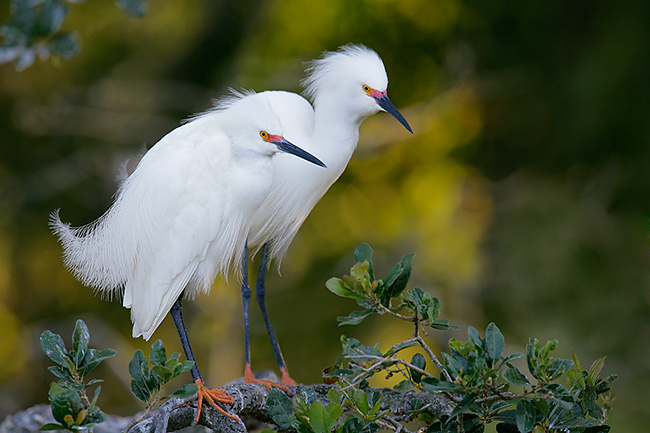
Snowy Egrets, mated pair on limb, St. Augustine Alligator Farm, St. Augustine, FL
Image Copyright 2007: Arthur Morris/BIRDS AS ART
Canon 500mm f/4L IS lens with 1.4X II TC and the EOS-1Ds Mark II. ISO 400. Evaluative metering +1/3 stop: 1/120 sec. at f/8.
Here, I opted for a bit more depth-of-field to sharpen up the bird in the rear. I spent about 20 minutes carefully removing white-wash from many of the leaves. Have I altered the natural history of the mage? To me, it is still a picture of two Snowy Egrets sitting on a branch. Just a prettier one…
BAA/GUSTAPHOTO AFRICAN SAFARI UPDATES
This August, I will make my seventh trip to Africa with Todd Gustafson. Each has been a fabulous success. Several couples sign up for almost every trip that we run. Our trips fill more than a year in advance. Why? We know where to be and when to be there. We hire the best guides. Our trips all feature only 3 photographers per van. All of our vans have three roof hatches making it possible to use your Wimberley head on a Todd Pod. Todd has the logistics down pat. All of our trips run as smoothly as can be expected. All of the hosts and managers know Todd and go out of there way to provide our groups with extra services.
Below is the info on the few remaining openings. To book a trip, or to request additional information, e-mail Todd at Gustaphoto@aol.com (Yeah, I have told him to get rid of AOL…)
Itinerary for Kenya late Sept/early OCT 2007. Leader: Todd Gustafson (8 spots open.)
(Note: this trip was added after our earlier one sold out.)
15 days on the ground $8,499.00. Includes: Park Fees, Vehicle and driver guides, Gas, Hotels and Meals, In-country flights.
Does not include: Air fare to and from Nairobi, Tips, Personal expenses (drinks, phone calls, email and personal items)
September 26: fly from US to Amsterdam
September 27: Fly Amsterdam to Nairobi/ Overnight in Nairobi
Sept 28 AM Transfer to Lake Naivasha CC. Tea at Elsemere (Colobus Monkeys.) PM boat ride
Sept 29 AM Crescent Island hike. PM photograph on the grounds or a boat ride on the lake. Overnight Naivasha CC
Sept 30 After breakfast transfer to Lake Nakuru for lunch. PM game drive Overnight Nakuru Lodge
Sept 31 AM and PM game drive Lake Nakuru. Overnight Nakuru Lodge
Oct 1 AM and PM game drive Lake Nakuru. Overnight Nakuru Lodge
Oct 2 AM game drive Lake Nakuru Transfer to Samburu PM game drive. Overnight Samburu Lodge
Oct 3 AM and PM game drives Samburu. Overnight Samburu Lodge
Oct 4 AM and PM game drives Samburu. Overnight Samburu Lodge
Oct 5 AM and PM game drives Samburu. Overnight Samburu Lodge
Oct 6 AM game drive Samburu. Drive to Sweetwaters PM Chimpanzee Reserve Overnight Sweet waters
Oct 7 AM game drive Sweetwaters. Drive to Amboseli PM game drive Overnight Ol Tu Kai
Oct 8 AM and PM game drives Amboseli PM game drive Overnight Ol Tu Kai
Oct 9 AM and PM game drives Amboseli PM game drive Overnight Ol Tu Kai
Oct 10 AM and PM game drives Amboseli PM game drive Overnight Ol Tu Kai
Oct 11 AM game drive transfer to Nairobi for 9 day rooms at Jacaranda flight to Amsterdam
Oct 12 Amsterdam to home
Itinerary for Kenya late July/early AUG 2008. Leaders: Arthur Morris & Todd Gustafson (10 spots open.)
15 days on the ground $10,499.00, Includes: Park Fees, Vehicle and driver guides, Gas, Hotel and Meals, In-country flights
Does not include: Air fare to and from Nairobi, Tips, Personal expenses (drinks, phone calls, email and personal items)
We are leaving the 28th of July for Amsterdam.
29 July fly Amsterdam to Nairobi
30 July is day 1of the Safari. Lake Naivasha
31 July Lake Naivasha and Elsemere
1 August Transfer to Lake Nakuru
2 Lake Nakuru
3 Lake Nakuru
4 Lake Nakuru
5 Lake Nakuru to Amboseli
6 Amboseli
7 Amboseli
8 Amboseli Fly to Maasai Mara
9 Maasai Mara
10 Maasai Mara
11 Maasai Mara
12 Maasai Mara
13 Maasai Mara Fly to Nairobi for Flight home
2009 Kenya/Seychelles Islands/Uganda for Mountain Gorillas : Arthur Morris & Todd Gustafson (6 spots open)
Late July- late August
Dates to be solidified
Prices to follow
For information on our Tanzania safaris please contact Toddi as above.
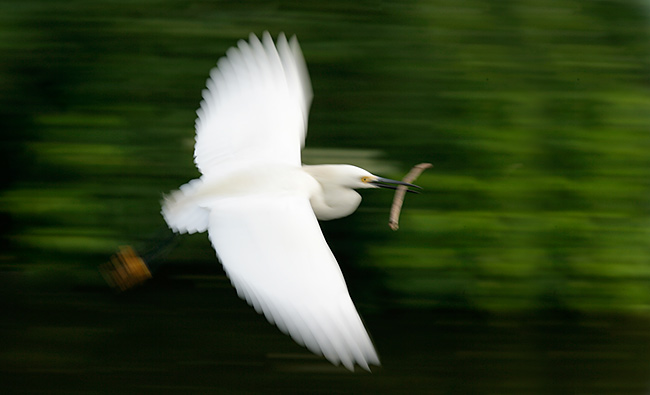
Snowy Egret w/nesting material, blur, St. Augustine Alligator Farm, St. Augustine, FL
Image Copyright 2007: Arthur Morris/BIRDS AS ART
Canon 70-200mm f/4L IS lens (handheld at 170mm) with 1.4X II TC and the EOS-1Ds Mark II. ISO 100. Evaluative metering -1 1/3 stops: 1/40 sec at f/10 in Tv mode.
It was extremely gratifying teaching the blur technique to several folks on the IPT and then seeing them create some wonderful images just minutes later. With blurs, not two are exactly the same.
There is a big section on creating pleasing blurs in ABP II: http://www.birdsasart.com/ABPII.htm
CANON GEAR FOR SALE
Posse member Robert Amoruso is offering the following items for sale:
1. A Canon 5D (Excellent shape
with 14K actuations based on my image numbering, minor cosmetic markings on
exterior and some dust in the pentaprism which has no affect on images and can
be cleaned. Sensor clean and unmarked. About 18 months old. Original packaging
and accessories including battery charger and extra batteries.) $2100
2. Canon BG-4E (Battery Grip for 5D) (Minor exterior markings but works great.
Two batteries included.) $190
3. Really Right Stuff BGE4-L Camera Plate for 5D w/Vertical Grip BG-4E (Perfect
condition.) $160
4. Canon 70-200mm f/2.8 “L” IS Zoom Lens and Hood (Some minor cosmetic markings
on exterior but IS and optics in excellent shape with no scratches.) $1400
5. Canon 70-200mm f/4 “L” non-IS Zoom Lens and ET-74 Lens Hood (Used very little
and in excellent shape; like new with perfect optics. About 14 months old.) $500
Reasonable offers will be considered. Please contact me at
wildscapeimages@adelphia.net or 407-808-7417. Images available on request.
Please contact Robert directly
with all requests for details including shipping and terms:
(cell) 407-808-7417 e-mail:
photo_rja@adelphia.net
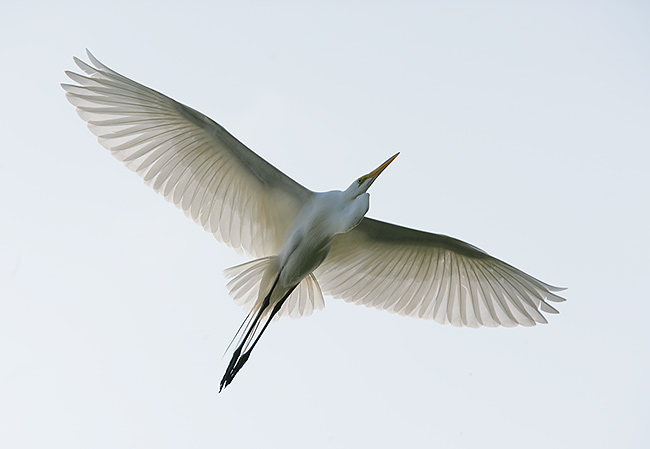
Great Egret, St. Augustine Alligator Farm, St. Augustine, FL
Image Copyright 2007: Arthur Morris/BIRDS AS ART
Canon 70-200mm f/4L IS lens (handheld at 195mm) with 1.4X II TC and the EOS-1Ds Mark II. ISO 200. Evaluative metering +2 2/3 stops off the sky set manually: 1/1000 sec. at f/5.6.
Though flight photography was not as great as in previous years we had lots of opportunities to teach everyone the intricacies.
SELECTED IPT UPDATES
The third Bosque IPT has been sold our for some time and #1 and #2 are filling quite nicely.
Bosque #1: "The Fall Color IPT" NOV 13-15, 2007. Slide Program on the evening of NOV 12. 3-DAY: $999. (Limit 14; openings: 7). Co-leader: Robert O'Toole. This IPT should feature a better chance for a day or two of the rare south winds that drastically improve flight photography and will definitely feature the brightest fall-color cottonwoods.
Bosque #2: "The Pre-Thanksgiving IPT" NOV 18-20, 2007. Slide Program on the evening of NOV 17. 3-DAY: $999. (Limit 14; openings: 7). Co-leader: Robert O'Toole & Alfred Forns. This IPT will feature increasing numbers of geese and cranes with lots of great opportunities. In 2007, I will again be hosting a Thanksgiving Day luncheon at Las Lunas Mansion, a fine restaurant in an historic building. You will need to reserve a spot and pay in advance. Details TBA; strictly limited to 50 folks.
Bosque #3: "The Post-Thanksgiving IPT" NOV 24-26, 2007. Slide Program on the evening of NOV 23. 3-DAY: $999. (Limit 14: Sold Out) Assistant leaders: Robert O'Toole, Robert Amoruso, and Alfred Forns. This IPT is scheduled on dates that I consider peak for Bosque. (There may be a Full Moon Add-on NOV 23; details TBA.) If you register for this one, hold off on buying your plane ticket if you might be interested in the add-on.) In 2007, I will again be hosting a Thanksgiving Day luncheon at Las Lunas Mansion, a fine restaurant in an historic building. You will need to reserve a spot and pay in advance. Details TBA; strictly limited to 50 folks.
SW FLA Post X-mas IPT: DEC 27-29, 2007). Slide program on the evening Wednesday, DEC 26, 2006. 3-DAY: $1029. (Limit 12) Co-leaders: Alfred Forns, & Robert O'Toole. Sanibel Island, Venice Rookery, Cape Coral, and possibly Little Estero Lagoon (depending on the tides). Herons, egrets, gulls, terns, skimmers, shorebirds, both pelicans, Osprey, Burrowing Owl, and lots more. Roseate Spoonbill and Wood Stork possible.
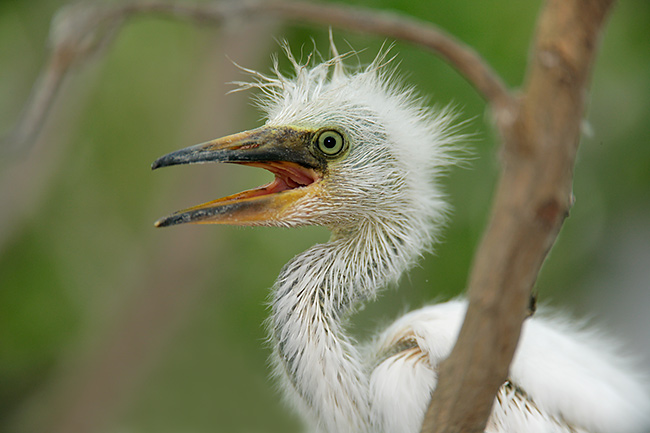
Snowy Egret chick begging, St. Augustine Alligator Farm, St. Augustine, FL
Image Copyright 2007: Arthur Morris/BIRDS AS ART
Canon 500mm f/4L IS lens with one 25mm extension tube, the 1.4X II TC, and the EOS-1Ds Mark II. ISO 400. Evaluative metering -1/3 stop: 1/400 sec at f/5.6.
Fill flash at -1 stop with Better Beamer.
One of the great lessons that we reinforced constantly on the last IPT was seeing and shooting “through the slot.” When working in cluttered places like rookeries you need to move around constantly looking for a clear opening to the subject. Sometimes, as I did here, you need to wait for the subject to move into your window…
Best and love and great picture-making to all,
artie
Note: Arthur Morris has been a Canon contract photographer since 1994 and continues in that role today. Hunt's Photo of Boston, MA is a BAA sponsor as it Delkin Devices. Back issues of all BAA Bulletins can be found in the Bulletin Archives which may be accessed from the home page at www.birdsasart.com